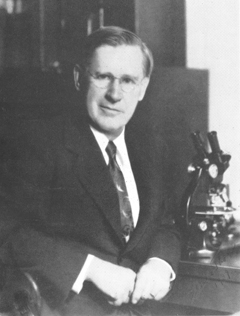Related Research Articles

Penicillium is a genus of ascomycetous fungi that is part of the mycobiome of many species and is of major importance in the natural environment, in food spoilage, and in food and drug production.

Penicillium roqueforti is a common saprotrophic fungus in the genus Penicillium. Widespread in nature, it can be isolated from soil, decaying organic matter, and plants.

Antarctica is one of the most physically and chemically extreme terrestrial environments to be inhabited by lifeforms. The largest plants are mosses, and the largest animals that do not leave the continent are a few species of insects.

Charles Thom was an American microbiologist and mycologist. Born and raised in Illinois, he received his PhD from the University of Missouri, the first such degree awarded by that institution. He studied the microbiology of dairy products and soil fungi, and in particular researched the genera Aspergillus and Penicillium. His work influenced the establishment of standards for food handling and processing in the USA. He pioneered the use of culture media to grow microorganisms, and, with food chemist James N. Currie, developed a process to mass-produce citric acid using Aspergillus. Thom played an important role in the development of penicillin in World War II.
Medicinal fungi are fungi that contain metabolites or can be induced to produce metabolites through biotechnology to develop prescription drugs. Compounds successfully developed into drugs or under research include antibiotics, anti-cancer drugs, cholesterol and ergosterol synthesis inhibitors, psychotropic drugs, immunosuppressants and fungicides.
Penicillium bovifimosum is a fungus species of the genus of Penicillium which was isolated from dry cow manure in Wyoming in the United States.
Penicillium brefeldianum is an anamorph fungus species of the genus of Penicillium which produces Brefeldin A a fungal metabolite.
Penicillium catenatum is an anamorph fungus species of the genus of Penicillium.
Penicillium cinnamopurpureum is a fungus species of the genus of Penicillium.
Penicillium herquei is an anamorph, filamentous species of the genus of Penicillium which produces citreorosein, emodin, hualyzin, herquline B, janthinone, citrinin and duclauxin,.
Penicillium inusitatum is a species of the genus of Penicillium.
Penicillium ludwigii is an anamorph species of the genus of Penicillium.
Penicillium ochrosalmoneum is an anamorph, ascosporic species in the genus Penicillium which produces citreoviridin.
Penicillium osmophilum is a species of fungus in the genus Penicillium which was isolated from agricultural soil in Wageningen in the Netherlands
Penicillium saturniforme is a species of fungus in the genus Penicillium. It was first described in 2009 as a species of Eupenicillium in 2009, but transferred to the genus Penicillium two years later. The fungus was isolated from soil in Jilin Province, China. Phylogenetically close species are P. glabrum, P. lividum, P. purpurascens, P. spinulosum, and P. thomii all of which are in the subgenus Aspergilloides.
Penicillium parvum is an anamorph species of fungus in the genus Penicillium which was isolated from soil in Papua New Guinea. Penicillium parvum produces ferrichrome siderophores
Penicillium pimiteouiense is a species of fungus in the genus Penicillium which was isolated from sandy beach soil from the Penang Island in Peninsular Malaysia.
Penicillium terrenum is an anamorph species of fungus in the genus Penicillium. Georegion is New Zealand.

Kaitocephalin is a non-selective ionotropic glutamate receptor antagonist, meaning it blocks the action of the neurotransmitter glutamate. It is produced by the fungus Eupenicillium shearii. Although similar molecules have been produced synthetically, kaitocephalin is the only known naturally occurring glutamate receptor antagonist. There is some evidence that kaitocephalin can protect the brain and central nervous system, so it is said to have neuroprotective properties. Kaitocephalin protects neurons by inhibiting excitotoxicity, a mechanism which causes cell death by overloading neurons with glutamate. Because of this, it is of interest as a potential scaffold for drug development. Drugs based on kaitocephalin may be useful in treating neurological conditions, including Alzheimer's, amyotrophic lateral sclerosis (ALS), and stroke.

Penicillium spinulosum is a non-branched, fast-growing fungus with a swelling at the terminal of the stipe (vesiculate) in the genus Penicillium. P. spinulosum is able to grow and reproduce in environment with low temperature and low water availability, and is known to be acidotolerant. P. spinulosum is ubiquitously distributed, and can often be isolated from soil. Each individual strain of P. spinulosum differs from others in their colony morphology, including colony texture, amount of sporulation and roughness of conidia and conidiophores.
References
- ↑ Amelia C. Stolk and De B. Scott, "Studies on the Genus Eupenicillium Ludwig", Persoonia 4 (1967): 391-405
- ↑ Yoko Yasuno et al., "(7S)-Kaitocephalin as a potent NMDA receptor selective ligand", Org. Biomol. Chem. 14 (2016): 1206-1210
- ↑ Philip Garner et al., "A concise [C+NC+CC] coupling-enabled synthesis of kaitocephalin", Chem. Commun. 50 (2014): 4908-4910